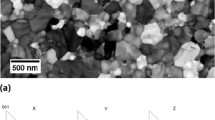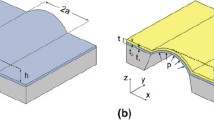Abstract
A new bulge testing setup for the measurement of the mechanical properties of thin films is presented. This self-built device can be incorporated in an atomic force microscope (AFM), which allows the recording of topographic images of the observed sample membranes under load conditions. Bulge test experiments on different silicon nitride films are presented and compared to nanoindentation experiments. The measured elastic moduli from nanoindentation and bulge testing are in good agreement. Apart from that, the ability to extract stress–strain data from AFM scans is shown, and the results are compared to standard bulge testing experiments. Imaging of the sample microstructure under load conditions is demonstrated on a thin Cu film.














Similar content being viewed by others
References
E. Arzt: Size effects in materials due to microstructural and dimensional constraints: A comparative review. Acta Mater. 46, 5611 1998
J.W. Beams: Mechanical properties of thin films of gold and silver Proceedings, International Conference on Structure and Properties of Thin Films Bolton Landing, NY 1959 edited by C.A. Neugebauer, J.B. Newkirk, and D.A. Vermilya (John Wiley, New York) 1959 183–192
O. Tabata, K. Kawahata, S. Sugiyama I. Igarashi: Mechanical property measurements of thin films using load–deflection of composite rectangular membranes. Sens. Actuators, A 20, 135 1989
A. Karimi, O.R. Shojaei, T. Kruml J.L. Martin: Characterisation of tin thin films using the bulge test and the nanoindentation technique. Thin Solid Films 308-309, 334 1997
Y. Xiang, X. Chen J.J. Vlassak: Plain-strain bulge test for thin films. J. Mater. Res. 20, 2360 2005
G. Binnig, C.F. Quante Ch. Gerber: Atomic force microscope. Phys. Rev. Lett. 56, 930 1986
J.J. Vlassak E.D. Nix: A new bulge testing technique for the determination of Young’s modulus and Poisson’s ratio of thin films. J. Mater. Res. 7, 3242 1992
E.I. Bromley, J.N. Randall, D.C. Flanders R.W. Mountain: A technique for the determination of stress in thin films. J. Vac. Sci. Technol., B 1, 1364 1993
A.J. Kalman, A.H. Verbruggen G.C.A.M. Jannsen: A novel bulge-testing seup for rectangular free-standing thin films. Rev. Sci. Instrum. 70, 4026 1999
A. Catlin W.P. Walker: Mechanical properties of thin single-crystal gold films. J. Appl. Phys. 31, 2135 1960
M.K. Small W.D. Nix: Analysis of the accuracy of the bulge test in determining the mechanical properties of thin films. J. Mater. Res. 7, 1553 1992
K. Durst, M. Göken H. Vehoff: Finite element study for nanoindentation measurements on two-phase materials. J. Mater. Res. 19, 85 2004
M. Göken, M. Kempf, M. Bordenet H. Vehoff: Nanomechanical characterization of metals and thin films. Surf. Interface Anal. 27, 302 1999
W.C. Oliver G.M. Pharr: An improved technique for determining hardness and elastic modulus using load and displacement sensing indentation experiments. J. Mater. Res. 7, 1564 1992
Hütte—Das Ingenieurwissen, 32nd ed., edited by H. Czichos and M. Hennecke (Springer-Verlag, Heidelberg 2004 E66
Y-G. Jung, B.R. Lawn, M. Martyniuk, H. Huang X.Z. Hu: Evaluation of elastic modulus and hardness of thin films by nanoindentation. J. Mater. Res. 19, 3076 2004
A.R. Reinberg: Plasma deposition of inorganic thin films. Annu. Rev. Mater. Sci. 9, 341 1979
Usermanual: Dimension 3100 ™ Scanning Probe Microscope, Digital Instruments–Veeco Metrology Group, Chadds Ford, PA, 2003
J.J. Vlassak: New experimental techniques and analysis methods for the study of mechanical properties of materials in small volumes. Ph.D. Dissertation, Stanford University, Stanford, CA, 1994
Acknowledgment
Christoph Richter of NanoWorld Services GmbH, Erlangen, Germany, is gratefully acknowledged for his advice and the production of the silicon nitride etch-stop layers.
Author information
Authors and Affiliations
Corresponding author
Appendices
Appendix A: Stress and Strain in Long Rectangular Membranes19
Imagine a cylindrical pipe bearing an internal pressure p which is cut in two halves along its axis of symmetry [Fig. A1(a)]. The wall thickness, the pipe length, and the radius of curvature are represented by t, l, and R, respectively. By balancing the forces, one finds
where σ is the stress in circumferential direction. Simple geometric relations show that, for h ≪ a:
Inserting Eq. (A2) in Eq. (A1) yields
The strain is obtained purely from geometric considerations as well [Fig. A1(b)]:
The Taylor expansion of θ is
Therefore
Substituting R by Eq. (A2) yields
Appendix B: Displacement Detector Alignment
During system operation the laser detector can be misaligned in two ways: lateral misalignment in the x direction and angular misalignment by tilting the stage relative to the laser axis.
1. Lateral misalignment
According to the bulge model, the membrane shape in the x–z plane is described as a segment of a circle. To have the origin of the coordinate system where it previously has been defined, the circular equation reads
where R is the radius of the circle. Using Pythagoras’ theorem, one finds
insertion in Eq. (A1) yields
for all z > 0. Negative values of z are not relevant in this consideration.
To check the lateral alignment accuracy of the setup, the light microscope of the AFM was focused on a prominent surface feature, and its coordinates relative to the origin of the AFM stage were recorded. Afterward, the stage was first moved to an arbitrary position and then repositioned to the defined coordinates. The effective distance between this point and the position of the prominent feature was determined to Δx = 70.7 μm and Δy = 59.0 μm, Δx and Δy being the average misalignment in the x and y directions, respectively. If the alignment process is made strictly unidirectional, thus eliminating the backslash of threads, these values decrease to 39.7 μm and 27.0 μm, respectively. Assuming a membrane half width of a = 1 mm and a membrane displacement of h = 70 μm, which are reasonable values, Eq. (A3) yields a relative error in displacement detection of 0.157% and 0.0084% for Δx = 39.7 μm and Δy = 29.0 μm, respectively.
2. Angular misalignment
To study the effect of sample tilting, the circle segment model is extended by a straight line representing the laser beam which passes the origin and is tilted by α. We assume perfect lateral alignment of the laser beam [Fig. A1(a)]. Hence, the trajectory of the laser beam is described by the simple equation
The x coordinate of the point of intersection is
The corresponding y coordinate is
The measured displacement is the distance between the origin and the point of intersection
Therefore, the error in the measurement equals
To stay below a detection error of 1%, a misalignment from the normal direction of 8° is tolerable, assuming the same values for a and h as mentioned above. This criterion is easily met in this experimental setup.
Rights and permissions
About this article
Cite this article
Schweitzer, E.W., Göken, M. In situ bulge testing in an atomic force microscope: Microdeformation experiments of thin film membranes. Journal of Materials Research 22, 2902–2911 (2007). https://doi.org/10.1557/JMR.2007.0373
Received:
Accepted:
Published:
Issue Date:
DOI: https://doi.org/10.1557/JMR.2007.0373





